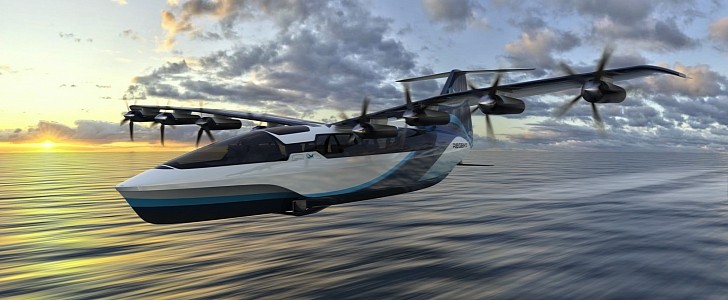Last spring, Boston-based company, Regent, announced the world’s first electric seaglider, a hybrid vehicle described as part aircraft, part boat. Its goal is to revolutionize maritime transportation, and thanks to the major milestone it recently reached, it has now moved one step closer to production.
Regent just announced that it has received Approval in Principle (AiP) from Bureau Veritas Marine & Offshore for its Viceroy, a 12-passenger, electric seaglider. According to Regent, the approval serves as an important certification milestone, offering “a clear path for the vehicle’s classification as a wing in ground effect (WIG) maritime vessel”.
The seaglider developer has been collaborating with Bureau Veritas Marine & Offshore’s engineers for 10 months now and this technical assessment represents an important moment for the vehicle’s design and technical maturity, as stated by Billy Thalheimer, Regent’s CEO. Bureau Veritas is a major global classification society that is backed up by 190 years of experience in reviewing and approving novel seagoing vessels such as Regent’s seaglider.
Next for Viceroy is to go through a design appraisal process that will allow for the implementation of that design and enable its operation in full compliance with the requirements.
Viceroy is advertised as a revolutionary all-electric seaglider that operates over the water as a WIG vehicle. When it is near the dock, it floats on its hull, foiling on its hydrofoils at up to 46 mph (74 kph) while it comes in and out of the port. This will keep the passengers onboard comfortable. But once it hits open water, Viceroy takes it up a notch, being able to hit up to 184 mph (296 kph).
The vessel is designed to carry up to 12 passengers and to cover routes of up to 180 miles (290 km) on a charge. However, that is an estimation based on current battery technology, with Regent being confident that next-gen batteries will increase that range to up to 500 miles (804 km).
Regent plans to launch its electric Viceroy in 2025 and boasts of having raised over $7B in orders so far, across aviation and ferry customers. Here’s a recent video with the seaglider in action.
The seaglider developer has been collaborating with Bureau Veritas Marine & Offshore’s engineers for 10 months now and this technical assessment represents an important moment for the vehicle’s design and technical maturity, as stated by Billy Thalheimer, Regent’s CEO. Bureau Veritas is a major global classification society that is backed up by 190 years of experience in reviewing and approving novel seagoing vessels such as Regent’s seaglider.
Next for Viceroy is to go through a design appraisal process that will allow for the implementation of that design and enable its operation in full compliance with the requirements.
Viceroy is advertised as a revolutionary all-electric seaglider that operates over the water as a WIG vehicle. When it is near the dock, it floats on its hull, foiling on its hydrofoils at up to 46 mph (74 kph) while it comes in and out of the port. This will keep the passengers onboard comfortable. But once it hits open water, Viceroy takes it up a notch, being able to hit up to 184 mph (296 kph).
The vessel is designed to carry up to 12 passengers and to cover routes of up to 180 miles (290 km) on a charge. However, that is an estimation based on current battery technology, with Regent being confident that next-gen batteries will increase that range to up to 500 miles (804 km).
Regent plans to launch its electric Viceroy in 2025 and boasts of having raised over $7B in orders so far, across aviation and ferry customers. Here’s a recent video with the seaglider in action.








